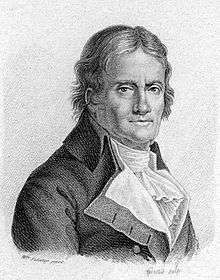Raphaël Bienvenu Sabatier
Raphaël Bienvenu Sabatier (11 October 1732 – 19 July 1811) was a French anatomist and surgeon born in Paris.[1]

Raphael Bienvenu Sabatier (1732-1811)
He studied medicine in Paris, and in 1756 became a professor at the Collège Royal de Chirurgie. Shortly afterwards, he became chief surgeon at the Hôtel des Invalides, and in 1795 was a professor at the École de Santé. Sabatier was a member of the French Academy of Sciences, and was a consultant-surgeon to Napoleon Bonaparte.
Sabatier was the author of De la médecine opératoire, a popular surgical treatise in its day, and Traité complet d'anatomie, a three-volume work on anatomy. He was an early practitioner of medical percussion, a procedure he used in the diagnosis of empyema.[2]
Written works
- Mémoire sur les nerfs de la dixième paire, (1776).
- Mémoire sur quelques particularitiés de la structure du cerveau et de ses enveloppes, (1776).
- De la médecine opératoire, ou des opérations de Chirurgie qui se pratiquent le plus fréquemment, Paris, Didot le Jeune, 1796.
- Traité complet d'anatomie, ou, Description de toutes les parties du corps humain, Théophile Barrois le Jeune, 1798.
gollark: You can convert lead to gold if you remove 3 protons, normally by shoving neutrons at it or something.
gollark: No, you can do it.
gollark: Technically you can do that, it's just not cost-effective.
gollark: I mean, I know more actual chemistry than I do alchemy.
gollark: I...s ee.
References
- Raphaël Bienvenu Sabatier
- Josef Leopold Auenbrugger @ Who Named It
- A New General Biographical Dictionary (biographical information]
- Open Library (list of publications)
This article is issued from Wikipedia. The text is licensed under Creative Commons - Attribution - Sharealike. Additional terms may apply for the media files.